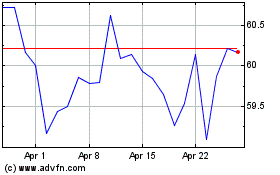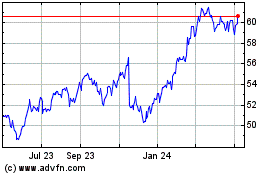Walmart Gets Back to Basics as Grocery Sales Grow -- Heard on the Street
May 18 2021 - 12:25PM
Dow Jones News
By Jinjoo Lee
Between competition from Amazon, big-box retailer peers and
traditional grocery stores, Walmart has a lot to worry about. Last
quarter's results should help ward off at least one fear.
The retailer on Tuesday reported better-than-expected results
for the quarter ended April 30, with comparable U.S. sales up 6%
compared with the 1.5% growth analysts polled by FactSet had
expected, boosted in part by stimulus payments. That growth is
especially impressive given that it is being measured against the
peak pandemic stockpiling period a year earlier, when comparable
sales grew 10.3%. Excluding the effects of some nonrecurring items,
earnings per share increased 43% from a year earlier.
The comparison with last year's frenzy was even favorable in
some ways. Walmart's bottom line was flattered by a higher mix of
general merchandise items compared with low-margin consumables such
as toilet paper and canned goods, which flew off the shelves last
year. Apparel, home goods and lawn and garden items all sold well
last quarter, Walmart's Chief Financial Officer Brett Biggs said on
an earnings call Tuesday morning. The bottom line was also helped
by a decline in Covid-related costs.
The biggest source of relief for Walmart was that it appeared to
gain back some market share in groceries. Earlier data from
Numerator for the year through March 31 showed that Walmart's
grocery market share in the U.S. declined to 20.1% from 22% a year
prior. That marked a contrast from Kroger, Costco and Target, which
all saw their grocery market share increase over the same
period.
Yet in the quarter ending April 30, Walmart said grocery sales
increased by a low-single digit percentage compared with a year
earlier, a solid performance given that supermarkets across the
U.S. saw sales decline 2.4% over the same period, according to data
from the U.S. Census Bureau.
Walmart might gain even more market share later this year,
driven by better foot traffic and inflation. A survey conducted on
May 10 by Inmar Intelligence showed that almost 90% of surveyed
adults noticed an increase in prices of groceries. The survey also
showed that price was the most important factor consumers
considered when considering where they shopped. That price
sensitivity should help Walmart, which pretty consistently has
lower prices than competitors.
For now, that means Walmart has to concentrate on a few
strategies, including its "everyday low prices" approach, rather
than spread itself too thin. The retailer said that it will focus
on building out capacity for grocery pickup and delivery for now
rather than growing its Walmart+ membership program.
Walmart shares gained almost 3% Tuesday morning, which was
notable given that its share price had dropped after every earnings
call in the previous four consecutive quarters. Yet Walmart still
trades more cheaply than peers at 0.7 times forward sales, compared
with 0.9 times for Costco and 1.1 times for Target, according to
FactSet.
Investors may need to see a couple more quarters of
unquestionable market share gains in the grocery aisles before
Walmart can close that valuation gap.
Write to Jinjoo Lee at jinjoo.lee@wsj.com
(END) Dow Jones Newswires
May 18, 2021 12:10 ET (16:10 GMT)
Copyright (c) 2021 Dow Jones & Company, Inc.
Walmart (NYSE:WMT)
Historical Stock Chart
From Aug 2024 to Sep 2024

Walmart (NYSE:WMT)
Historical Stock Chart
From Sep 2023 to Sep 2024
